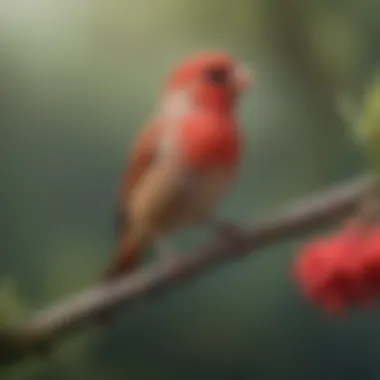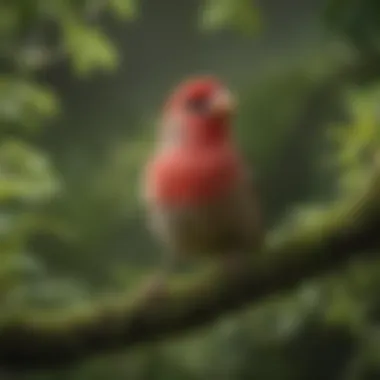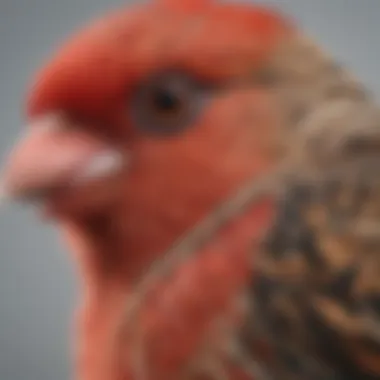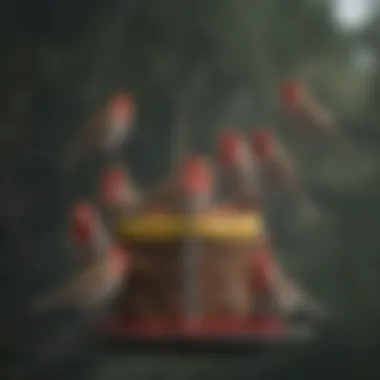In-Depth Exploration of the Red Finch Bird Species


Intro
This article explores the intricate world of the red finch bird, a member of the finch family, known scientifically for its various species. Both fascinating and essential, red finches inhabit diverse environments and possess unique behaviors that contribute significantly to their ecosystems. This exploration will highlight their classification, physical traits, habitats, behaviors, and the ongoing conservation efforts crucial for their survival.
Animal Overview
Common Name and Scientific Classification
The red finch, commonly recognized for its vivid plumage and charming presence, belongs to the Carpodacus genus. These birds are essentially associated with the house finch and the purple finch. Their scientific classifications offer insights into their evolutionary relationships within the broader finch family.
Physical Characteristics
Red finches usually exhibit bright red feathers on their heads and chests, which varies in intensity among species. Other characteristics include a stout beak adapted for seed consumption and a relatively compact body structure. Females tend to have more subdued colors, often displaying brown and streaked plumage, aiding in camouflage during nesting.
Habitat and Distribution
These birds inhabit a variety of environments, ranging from urban settings to rural areas. They thrive in open woodlands, gardens, and shrublands. Their adaptability allows them to establish homes across North America and parts of Central America.
Behavior and Social Structure
Communication Methods
Red finches communicate through a range of vocalizations. Males are particularly known for their melodic songs during the breeding season, which serve to attract mates and assert territorial claims.
Social Hierarchies
Social structures among red finches can vary based on their environment. They are generally social birds, often seen in flocks. In these groups, dominance hierarchies can emerge, influencing feeding and mating behaviors.
Mating and Reproductive Behavior
During the mating season, males perform elaborate displays to attract females. Nesting typically occurs in shrubs or trees, where the female builds a nest with various materials. After laying eggs, both parents may participate in feeding their young.
Conservation Status
Current Population Trends
The population of red finches has experienced fluctuations over recent decades. Current estimates indicate a stable trend in certain areas, although data reflects concerns in others.
Threats and Challenges
Red finches face challenges primarily due to habitat loss and climate change. Urbanization and agricultural expansion disrupt their natural environments, leading to decreased food availability and nesting sites.
Conservation Efforts and Success Stories
Many organizations work toward the conservation of red finches. These efforts include habitat restoration and public awareness campaigns. Some regions have reported positive outcomes with increased populations resulting from targeted conservation practices.
The red finch is not just a beautiful bird; it plays an important role in maintaining ecological balance.
In summary, understanding the red finch bird encompasses a broad spectrum of knowledge, from biological classification to the impact of environmental changes. As we delve deeper into this intriguing species, we emphasize their significance in the environment and the urgent need for continued conservation efforts.
Prologue to the Red Finch
The exploration of the red finch introduces readers to a species that embodies both beauty and ecological significance. Understanding the red finch is vital for numerous reasons. Firstly, these birds serve as an indicator of environmental health, reflecting the conditions of their habitats. Studying their behaviors and populations can provide insight into broader ecological trends.
Additionally, the red finch is a part of a larger finch family, which showcases a variety of species, each contributing uniquely to their ecosystems.
Defining the Red Finch


The term 'red finch' refers to several species within the finch family characterized by their distinctive red plumage. This includes birds like the House Finch, which showcases bright red color in males, and the Purple Finch, where the red hue appears in varying shades. The Common Redpoll, another member of this avian group, is often recognized by its small size and bold markings.
The red finch is not just defined by color, but also by its behaviors and habitats. They are often found in open woodlands, gardens, and parks, occupying areas where they can readily access food sources like seeds and berries.
Importance of Studying Finch Species
Studying finch species, particularly the red finch, provides broad implications for conservation and biodiversity. These birds engage in seed dispersal, significantly affecting plant communities. Understanding their feeding habits can guide conservationists in managing their habitats, ensuring food security for various species, including humans.
Moreover, red finches are often accessible for observation, making them suitable subjects for educational initiatives. Families, educators, and wildlife enthusiasts can benefit from tracking their behaviors and contributions to ecosystems. The investigation into red finches not only enhances our knowledge of avian diversity but also emphasizes the interconnectedness of all species within an ecosystem.
Understanding red finches is not merely an academic exercise; it invites appreciation and responsibility toward preserving biodiversity and our natural world.
Taxonomy of the Red Finch
Understanding the taxonomy of red finches is crucial in the effort to appreciate their ecological role and conservation status. Taxonomy provides clarity about the relationships between different species and helps illuminate their diverse characteristics. This knowledge enhances our understanding of biodiversity and informs conservation strategies, which is essential in maintaining healthy ecosystems.
Family and Order Classification
Red finches belong to the family Fringillidae, which is often referred to as the finch family. This family is part of the order Passeriformes, known as perching birds. Within this classification, red finches are recognized for their distinctive features and behaviors that set them apart from other bird families. The classification helps scientists and bird enthusiasts identify and study their traits and habitats more accurately.
Different Species of Red Finches
House Finch
The House Finch is perhaps one of the most commonly recognized species in urban environments. This species is adaptable and has a strong presence across many North American cities. Notably, House Finches have a unique feature: their plumage can vary significantly based on their habitat and diet, showcasing shades from bright red to subdued brown. This adaptability makes them a beneficial subject of study within this article, as they reflect the impact of human activity on natural behaviors.
They thrive on seeds, fruits, and even scraps from urban settings, demonstrating their flexibility in diet and living conditions.
Purple Finch
The Purple Finch is often seen in more wooded areas compared to its House Finch counterpart. This species is distinguished by its striking coloration; males have a more pronounced rosy hue on their chests, which fades into a brownish color toward their back. The Purple Finch’s unique feature is its conical bill, perfect for cracking seeds, which illustrates its adaptation to specific food sources, making it a popular choice for this article.
While less common in urban areas, their preference for ripe fruits and tree seeds showcases their role in natural food webs and ecosystems.
Common Redpoll
The Common Redpoll is a smaller finch species, often found in Northern regions. Its key characteristic is its distinctive red cap, which is particularly vibrant among males. Moreover, they are known for gathering in flocks, which can be a fascinating behavior to observe. This social aspect contributes to the broader understanding of avian interactions and survival strategies. Their preference for seeds from birch and other trees makes them integral to the health of these forested environments.
In summary, exploring the taxonomy of the red finch not only aids in understanding each species individually but also emphasizes their contribution to biodiversity and ecological stability.
Physical Characteristics
Understanding the physical characteristics of red finches is crucial for several reasons. These traits not only define the species but also play an important role in their adaptation to various environments. By studying these characteristics, one can appreciate how they contribute to survival, reproduction, and interaction within their ecosystems.
Coloration and Appearance
Red finches display a variety of coloration and appearance that can vary significantly among species and even between genders. The most recognizable feature is their plumage, which often includes striking red or pink hues. For instance, the male House Finch typically showcases bright red on the head, throat, and chest, while females have more subdued, streaky brown feathers. This sexual dimorphism is vital for their mating behavior, where males use their vivid colors to attract females. Apart from coloration, the beak of the red finch is robust, reflecting their seed-based diet. It is designed to crack open various types of seeds, which are abundant in their natural habitats.
Red finches are known for their vibrant plumage and adaptability, making them a fascinating subject for study in avian biology.
Size and Weight Variations
Size and weight can vary among red finch species, affecting their ecology and behavior. Generally, these birds range from 5 to 7 inches in length, with weight fluctuating between 0.5 to 1 ounce. The House Finch is among the larger species, while the Common Redpoll is smaller in size. These variations may influence factors like flight patterns and territoriality. Larger finches may defend broader territories, while smaller ones might rely more on flocking behavior for safety and foraging efficiency. Understanding these differences in size and weight can provide insights into their adaptive strategies and how they respond to environmental pressures.
Habitat and Distribution
Understanding the habitat and distribution of red finches is essential for recognizing their ecological roles and needs. Each species within this group thrives in specific environments, which directly influence their behavior, diet, and survivability. Identifying these habitats not only aids in the conservation efforts but also assists in predicting how changes in the environment can affect their populations. This section will delve into the natural habitats favored by red finches and their geographical spread across various regions.


Natural Habitats of Red Finches
Red finches commonly occupy a range of habitats, often demonstrating flexibility in their environment preferences. They can be found in both urban and rural settings, adapting to human presence while also thriving in more natural surroundings. Key natural habitats include:
- Woodlands and Forest Edges: Many species of red finches prefer mixed woodlands with an abundance of shrubs and trees, which provide a rich source of seeds and nesting materials. The edges of these forests offer adequate cover from predators.
- Grasslands: Open fields and prairies are ideal for certain species that forage on seeds from grasses and wildflowers.
- Shrublands: Areas with dense shrubs present excellent feeding and nesting opportunities. The structure of shrubs allows for protection while offering easy access to seeds.
- Urban Areas: Species like the House Finch are particularly adept at living in cities. They make use of gardens, parks, and even window ledges for nesting sites, showcasing their adaptability.
Geographical Distribution
The geographical distribution of red finches varies significantly among species. They inhabit a wide range of climates and regions in North America and parts of Central America. Notably, the House Finch is found across most of the United States, stretching from coast to coast. It has also been introduced into areas outside its native range, including parts of Hawaii.
In contrast, the Purple Finch prefers coniferous forests, typically in the northern parts of the continent. Their range extends into Canada and parts of the northeastern United States. The Common Redpoll typically occupies the Arctic regions in Canada during breeding seasons but migrates to southern parts of Canada and northern U.S. states during winter.
Understanding their distribution patterns is vital in conservation work. Changes in climate and habitat due to urban development or agriculture can impact where red finches can thrive.
The adaptability of red finches to urban environments is a remarkable testament to their resilience. However, this adaptability also highlights the urgent need for ongoing conservation efforts to ensure suitable habitats remain available.
Diet and Feeding Habits
Understanding the diet and feeding habits of the red finch is crucial for comprehending its ecological role and survival strategies. This section examines what these birds consume in their natural habitats and how their diet adapts in urban settings. Such knowledge is relevant not only for bird watchers but also for those involved in wildlife conservation and management. We will look at their food sources, eating behaviors, and the impact of environmental changes on their diet.
Natural Diet in the Wild
In the wild, red finches typically have a varied diet that reflects their adaptation to different environments. They primarily feed on seeds, berries, and insects. Seeds from grasses and weeds form the largest part of their diet. Red finches show a preference for sunflower seeds, which are rich in fat and energy.
Key points about their natural diet include:
- Seed preference: They favor seeds that are abundant and easily accessible.
- Seasonal variations: Berries and insects become more significant in the diet during spring and summer months when they are plentiful.
- Nutritional needs: The availability of nutrients from fruits and insects aids in reproductive health, especially during the breeding season.
Observations of red finches foraging in the wild reveal interesting behavior patterns. They often feed in flocks, which helps them locate food and deter predators. Their ability to adapt their diet based on seasonal changes enhances their chances of survival in varying habitats.
Feeding in Urban Areas
As cities expand worldwide, red finches increasingly inhabit urban areas. Their feeding habits have adapted to these altered environments. In urban settings, they often consume food from backyards, parks, and gardens. People can attract red finches by providing bird feeders stocked with seeds.
Urban feeding habits highlight the following aspects:
- Diverse food sources: In addition to seeds, they may consume fruits and scraps left by humans.
- Increased competition: Urban areas may have higher competition for food, requiring red finches to adapt their foraging behaviors.
- Health considerations: Feeding in urban areas can expose birds to pollutants and chemicals, raising concerns about their health and survival.
It is essential to understand how red finches adjust their diet in urban areas, as these changes may influence their overall health and reproduction.
This duality in their diet illustrates the resilience of the red finch in changing environments, providing insight into their survival mechanisms. Monitoring these feeding habits helps in conservation efforts and enhances our understanding of avian ecology in human-dominated landscapes.
Behavior and Social Structure
Behavior and social structure play a pivotal role in understanding red finches. Their interactions influence mating, survival, and their overall impact in the ecosystem. Observing these aspects helps to illustrate how red finches relate to their environment. A comprehensive view of their behavior provides insights into their adaptability and resilience in changing habitats.
Mating and Reproduction
Red finches exhibit a variety of mating behaviors that are key to their reproductive success. Courtship rituals involve males performing intricate displays to attract females. These displays can include singing and physical posturing. The quality of these performances often correlates with the male's health and vitality, indirectly influencing female choice.
During mating season, nesting takes on a significant role. Finches typically build nests in shrubs or trees, utilizing materials like grasses, feathers, and even paper. The location of the nest can protect it from predators and harsh weather, which is a skillful instinct in ensuring the survival of their offspring.
The typical clutch size ranges from 3 to 6 eggs, with both parents often involved in the incubation process. After hatching, the chicks are reliant on their parents for food and protection. This cooperative behavior aids in the survival of the young, showcasing the importance of family structure within finch populations.
Communication and Song
Communication among red finches extends beyond vocalizations, though their songs are particularly notable. Males use song to declare territory and attract females. The variety and complexity of their songs can indicate their health and vigor. This acoustic signaling plays a critical role in maintaining social cohesion and managing conflicts over territory.


In addition to singing, red finches utilize body language and visual displays to communicate. During confrontations or courtship, positioning and movement can signal intentions and help reduce aggression.
Research has shown that understanding these communication forms can reveal much about the social dynamics of finch populations, affecting both their survival and reproduction.
While finches are not strictly social birds, they often form loose flocks, especially in the non-breeding seasons. This flocking behavior provides advantages such as enhanced foraging efficiency and increased vigilance against predators. Evaluating their social interactions enrich our knowledge of their adaptability and strategies for thriving in diverse environments.
In summary, studying the behavior and social structure of red finches is crucial for appreciating their ecological roles and contributions. Their mating habits and communication methods reflect a species that is both resilient and adaptable to various environments.
Role in the Ecosystem
Understanding the role of red finches in their ecosystem is crucial for appreciating their contributions to biodiversity and environmental health. These birds not only serve as prey for various predators but also help in the sustenance of plant life through their feeding habits. Their activities foster ecological balance and promote robust habitats.
Seed Dispersal and Plant Health
Red finches play a vital role in seed dispersal, which is essential for the growth of many plant species. As they feed on seeds and berries, they inadvertently transport these seeds over varying distances. When they excrete undigested seeds, it aids in planting new vegetation in diverse areas. This process promotes genetic diversity in plant populations, allowing for healthier ecosystems.
Moreover, the presence of red finches can indicate healthy vegetation. Their feeding habits often support the health of particular types of plants, which can lead to a more stable environment. In urban settings, they are commonly found in gardens, aiding in pollination and assisting in keeping plant populations sustainable.
Research shows that finch populations can significantly affect the distribution of plant species, enhancing community structures in their respective habitats.
Biodiversity and Habitat Contribution
The contribution of red finches to biodiversity extends beyond their individual species. They interact with various plants and other animal species, thus playing an integral part in community ecology. Their feeding habits contribute to the dynamics of food webs, impacting other organisms in the ecosystem.
Red finches help in controlling insect populations by feeding on them, which can sometimes act as pests to flowers and crops. This natural pest control is an advantage for agricultural activities. The impact of their presence is noticeable in fostering a balanced ecosystem, allowing other species to thrive.
Overall, red finches enhance the biodiversity of their environment by supporting the growth of various plants and displacing pests. Their role exemplifies the interconnectedness of species within an ecosystem, revealing how each species contributes to a greater environmental tapestry.
This interaction highlights the need for conservation, as maintaining healthy red finch populations is essential for sustaining diverse habitats.
Conservation Status
Understanding the conservation status of red finches is crucial in shaping effective wildlife management policies and ensuring the sustainability of their populations. Conservation efforts impact not only the health of the species but also the ecosystems they inhabit. Furthermore, studying red finches provides insights into broader environmental issues, allowing conservationists to address the multifaceted challenges facing avian populations today.
Threats Facing Red Finches
Red finches encounter several threats that hinder their survival. These threats can be categorized into natural and human-induced factors.
- Habitat Loss: Urban development, agriculture, and deforestation have reduced the natural habitats available for red finches. These changes can lead to fewer nesting sites and food sources.
- Climate Change: Fluctuations in climate can alter migration patterns, breeding seasons, and food availability. Red finches may struggle to adapt to these changes, impacting their reproductive success.
- Predation and Competition: Introduction of non-native species and domestic animals increase predation pressures on red finches. Additionally, competition with other birds for resources can limit their growth and reproduction.
Maintaining the biodiversity of red finches is essential to protect them from these ongoing threats, as they play a key role in their ecosystems.
Conservation Efforts
Conservation initiatives aimed at protecting red finches are vital for ensuring their survival. Several measures can be put in place:
- Habitat Restoration: Efforts to restore natural habitats can significantly benefit red finches. Activities might include replanting native vegetation and creating protected areas to preserve their homes.
- Monitoring Programs: Ongoing population studies help assess red finch numbers and their habitats. This data is essential in understanding population trends and addressing specific threats.
- Community Engagement: Raising awareness about the importance of red finches enhances public support for conservation efforts. Educational programs can encourage communities to take part in habitat restoration and protection.
By combining scientific research with active community participation, conservationists can help secure a future for red finches in the wild.
Epilogue
The conclusion of this article serves as a critical synthesis of the discussions presented throughout. Understanding the red finch is not merely an academic exercise but a necessary step towards appreciating their role in the ecosystem and the biodiversity they contribute to. The topics covered highlight the significance of these birds in seed dispersal, their adaptability in various habitats, and the threats they currently face.
Summary of Key Points
- Defining the Red Finch: We examined the many species within the finch family, such as the House Finch, Purple Finch, and Common Redpoll, identifying their unique traits.
- Physical Characteristics: The article explored their coloration, size, and weight variations, showcasing how these factors are relevant to their behaviors and habitats.
- Habitat and Distribution: We discussed their preferred natural habitats and geographical range, emphasizing how these influence their survival.
- Diet and Feeding Habits: The eating patterns of red finches in the wild and urban areas were analyzed, indicating their adaptability to human environments.
- Behavior and Social Structure: Mating, reproduction, and communication through song were explored, revealing the complex social dynamics of these birds.
- Role in the Ecosystem: Their importance in seed dispersal and maintaining plant health was highlighted, enhancing our understanding of their ecological contributions.
- Conservation Status: The threats facing red finches, alongside the ongoing conservation efforts aimed at protecting these species, underscore the urgency of their preservation.
- Future Research Directions: There is a growing need for more research focused on the impact of climate change on red finch populations and their adaptability.
Future Research Directions
Further studies could delve into the following areas:
- Effects of Urbanization: Investigate how urban environments continue to influence the dietary habits and breeding strategies of red finches.
- Genetic Studies: Conduct genetic analyses to understand the adaptability of different species within the finch family and their potential for evolution in changing environments.
- Climate Impact Analysis: Explore how climate change is altering the geographical distribution of red finches and what that means for their future.
- Public Awareness: Promoting awareness about the conservation status and the ecological roles of red finches can help in fostering community-based conservation efforts.







